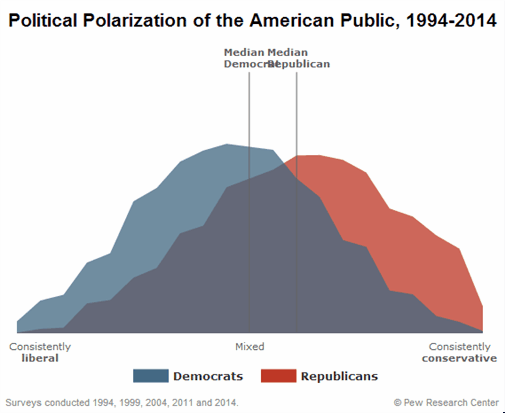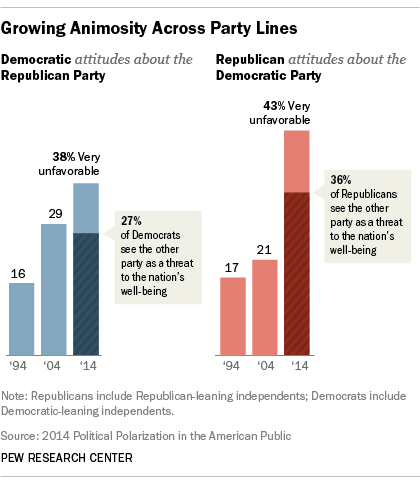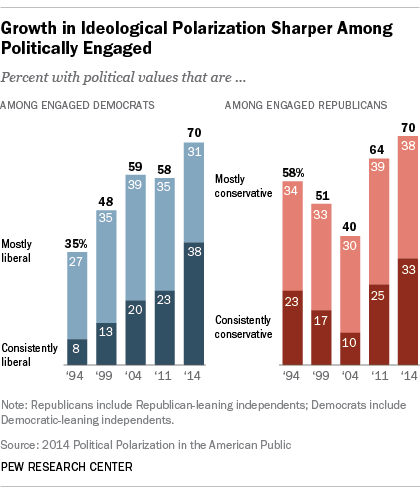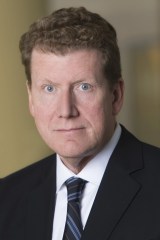https://www.youtube.com/watch?v=yOocxd9qGHA Political polarization is the defining feature of early 21st century American politics, both among the public and elected officials. As part of a year-long study of polarization, the Pew Research Center has conducted the largest political survey in its history – a poll of more than 10,000 adults between January and March of this year. It finds that Republicans and Democrats are further apart ideologically than at any point in recent history. Growing numbers of Republicans and Democrats express highly negative views of the opposing party. And to a considerable degree, polarization is reflected in the personal lives and lifestyles of those on both the right and left.
Here are 7 key findings on polarization in America today:

The share of Americans who express consistently conservative or consistently liberal opinions has doubled over the past two decades, from 10% to 21%. As a result, the amount of ideological overlap between the two parties has diminished. The “median,” or typical, Republican is now more conservative than 94% of Democrats, compared with 70% twenty years ago. And the median Democrat is more liberal than 92% of Republicans, up from 64%. Among Republicans and Democrats who are highly engaged in politics, 70% now take positions that are mostly or consistently in line with the ideological bent of their party.

Partisan antipathy has risen. The share of Republicans who have very unfavorable opinions of the Democratic Party has jumped from 17% to 43% in the last 20 years. Similarly, the share of Democrats with very negative opinions of the Republican Party also has more than doubled, from 16% to 38%. But these numbers tell only part of the story. Among Republicans and Democrats who have a very unfavorable impression of the other party, the vast majority say the opposing party’s policies represent a threat to the nation’s well-being.
“Ideological silos” are now common on the right and, to a lesser extent, the left. About six-in-ten (63%) consistent conservatives and 49% of consistent liberals say most of their close friends share their political views, compared with just 35% among the public as a whole.
Differences between the right and left go beyond politics. Three-quarters of consistent conservatives say they would opt to live in a community where “the houses are larger and farther apart, but schools, stores and restaurants are several miles away,” while 77% of consistent liberals prefer smaller houses closer to amenities. Nearly four times as many liberals as conservatives say it is important that their community has racial and ethnic diversity; about three times as many conservatives as liberals say it is important that many in the community share their religious faith.
The center has gotten smaller: 39% of Americans currently take a roughly equal number of liberal and conservative positions, down from 49% in surveys conducted in 1994 and 2004. And, those with mixed ideological views are not necessarily “moderates.” Despite their mixed ideological views in general, many express very conservative – or very liberal – opinions, depending on the specific issue. As a result, many current policy debates, such as immigration, gun control and health care policy, inspire nearly as much passion in the ideological center as on the left or the right.

The most ideologically oriented Americans make their voices heard through greater participation in every stage of the political process. Self-reported voting rates are higher among those on the right than the left, but higher among those on the left than in the middle. Political donation rates are roughly double the national average among ideologically consistent liberals (31% have donated money) and conservatives (26%).
To those on the ideological right and left, compromise now means that their side gets more of what it wants. About six-in-ten across-the-board liberals (62%) say the optimal deal between President Barack Obama and the GOP should be closer to what Obama wants. About as many consistent conservatives (57%) say an agreement should be more on the GOP’s terms.
